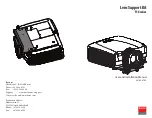
Image: E
5
Sensor which it is not possible to set: The sensor is set to factory settings and
ready for operation.
Refer to graphics C and G to check the function. If the switching output fails to
behave in accordance with graphic C, check application conditions. See section
Fault diagnosis.
0 %
100 %
0 %
100 %
0 %
100 %
0 %
100 %
0 %
100 %
0 %
100 %
0 %
100 %
0 %
100 %
Sensing range min.
Sensing range max.
Set switching point
Image: F
Sensor with potentiometer:
The sensing range is adjusted relative to the background with the potentiometer
(type: 270°). Clockwise rotation: sensing range increased; counterclockwise rota‐
tion: sensing range reduced. Turn the potentiometer clockwise until the yellow LED
indicator lights up. When an object is moved into the path of the beam, the yellow
LED indicator must go out. If the yellow LED indicator remains lit when an object is
moved into the path of the beam, repeat the adjustment.
The optimum setting can be achieved and checked using the signal strength light
bar on the back of the sensor. The LEDs on the signal strength light bar light up in
relation to the object position and the set switching point. If no LEDs or only the red
LEDs light up, the object is positioned in front of the set switching point and cannot
be detected. The first yellow LED lights up when the object is behind the set switch‐
ing point. More green LEDs light up when the object is moved further away from the
sensor into the background (see graphic F).
The sensor is adjusted and ready for operation. Refer to graphics C and G to check
the function. If the switching output fails to behave in accordance with graphic C,
check application conditions. See section Fault diagnosis.
COMMISSIONING
3
8017859 | SICK
Subject to change without notice
3





































